![]()
![]()
![]()
Use LEFT and RIGHT arrow keys to navigate between flashcards;
Use UP and DOWN arrow keys to flip the card;
H to show hint;
A reads text to speech;
71 Cards in this Set
- Front
- Back
- 3rd side (hint)
|
What are three Building Block of UML?
|
Elements - the abstractions that are first-class citizens in a model; Relationships - tie these elements together; Diagrams - group collections of related elements by means of relationships.
|
|
|
|
What are the four kinds of Elements?
|
Structural, Behavioral, Grouping, Annotational
|
|
|
|
What is a Structural Element?
|
Used to create the static parts of a model by representing elements that are conceptual or physical
|
|
|
|
What is a behavioral element?
|
Allows you to model the behavior of the system
|
|
|
|
What is the Grouping Element?
|
Allows you to organize the structural and behavioral elements in your model
|
|
|
|
What are Annotational Elements?
|
Explanatory parts of the model.
|
|
|
|
What are the 7 Structural Elements?
|
Class, interface, collaboration, use case, active Class, Component, Node
|
|
|
|
What are the 2 types of Behavioral Elements?
|
Interaction notation and state machine
|
|
|
|
What are three Building Block of UML?
|
Elements - the abstractions that are first-class citizens in a model; Relationships - tie these elements together; Diagrams - group collections of related elements by means of relationships.
|
|
|
|
What are the four kinds of abstract UML Elements?
|
Structural, Behavioral, Grouping, Annotational
|
|
|
|
What is a Structural Element?
|
Used to create the static parts of a model by representing elements that are conceptual or physical
|
|
|
|
What is a behavioral element?
|
Allows you to model the behavior of the system
|
|
|
|
What is the Grouping Element?
|
Allows you to organize the structural and behavioral elements in your model
|
|
|
|
What are Annotational Elements?
|
Explanatory parts of the model.
|
|
|
|
What are the 7 Structural Elements?
|
Class, interface, collaboration, use case, active Class, Component, Node
|
Elements that are irrespective of time. Includes class, composite structure, component, deployment, object, and package diagrams.
|
|
|
What are the 2 types of Behavioral Elements?
|
Interaction Notation (solid arrow line), state machine
|
Do not confuse behavioral diagrams with behavioral elements.
|
|

What element is this?
|
Grouping Element
|
|
|
|
What are the four standard relationships in UML?
|
Dependency, Association, Generalization and Realization
|
|
|
|
What is a dependency?
|
A dependency is a semantic relationship between two elements in which a change to one thing can affect the semantic of the other thing.
|
|
|
|
What is an association?
|
A structure relationship that describes a set of links. A link is a connection among objects.
|
|
|
|
How is multiplicity represented for a professor to course offering
|
professor 0..1 may or may not teach a course.
A course or multiple courses 0..* may be taught by a professor. |
|
|
|
How is zero or more represented in multiplicity?
|
0..* or *
|
|
|
|
How is One or more represented?
|
1..*
|
|
|
|
How is Zero or One represented in multiplicity?
|
0..1
|
|
|
|
Show a specified range in multiplicity
|
2..4
|
|
|

What kind of relationship text is this?
|
An aggregation association. THe open diamond is on the side of the whole.
|
|
|

What does this represent?
|
A composition relationship between a whole and its part.
|
|
|

What does this picture show?
|
A realization relationship between classifiers where one classifier specifies a contract that another classifier guarantees to carry out.
|
|
|
|
What are the three types or relationships between use cases?
|
Extend, include and generalization
|
|
|
|
What is a Use Case Generalization?
|
A relationship from a child use case to a parent use case, specifying how a child can specialize all behavior anc characteristics described for the parent.
|
|
|
|
What is a Use Case Extend relationship?
|
It specifies the behavior of a use case may be augmented by an additional use case. Specifies conditional behavior.
|
|
|
|
What is a Use Case Include relationship?
|
An include is a directed relationship between two use cases, implying that the behavior of the included use case is inserted into the behavior of the base use case. Always required for the base use case.
|
|
|
|
What is the purpose of a Class Diagram?
|
It is used for describing structure and behavior in the use cases. It is used for requirement capture and end-user interaction. Detailed class diagrams are used for developers.
|
|
|
|
What do +, - and # stand for in a class diagram?
|
+ is Public visibility
# is Protected visibility (friends) - is private visibility (black box) |
|
|
|
What are the three sections of a class diagram?
|
Name, attribute and Operations (methods)
|
|
|
|
What are the two different kinds of associations?
|
Aggregation and composition
|
|
|
|
What are two different kind of OO relationships?
|
Generalization (parent/child)
Association (student enrolls in course) |
|
|
|
Describe an aggregation relationship metaphor.
|
It is a Container-Containee relationship. A Container class can be the bag and the apples and milk are the containee class. They can exist without the container.
|
|
|
|
What is the purpose of Interaction Diagrams?
|
A Sequence, Communication/Collaboration, Interaction Overview or Timing diagram. They are used for assigning responsibilities. Can be Process View perspective.
|
|
|
|
What are the different interaction diagrams?
|
Sequence Diagram
Communication Diagram Interaction Overview Diagram Timing Diagram |
|
|
|
What are the different Structure Diagrams?
|
Class, Component, Composite structure, Package, Deployment, Object
|
|
|
|
What are the different Behavior Diagrams?
|
Activity, Use Case, State Machine
|
|
|
|
What is the purpose of a State Diagram?
|
It represents the different states that objects in the system undergo during their lifecycle. Objects in the system change states in response to events.
|
|
|
|
What is the purpose of an Activity Diagram?
|
Captures the process flow of the system. An activity diagram also consists of activities, actions, transitions and initial and final states.
|
|
|
|
What is the purpose of a Sequence diagram?
|
It represents the interaction between different objects in the system. The important aspect of a sequence diagram is that it is time ordered.
|
|
|
|
What is the purpose of a deployment diagram
|
It captures the configuration of the runtime elements of the application. This diagram is useful when a system is complete and ready for deployment.
|
|
|
|
What is a Component diagram?
|
It represents the high-level parts that make up the system. This diagram depicts what components form part of the system and how they are interrelated. It depict the components culled after the system has undergone the development or construction phase.
|
|
|
|
What is the purpose of using an Activity Diagram?
|
The main reason to use activity diagrams is to model the workflow behind the system being designed. However, activity diagrams should not take the place of interaction diagrams and state diagrams. Activity diagrams do not give detail about how objects behave or how objects collaborate
|
|
|
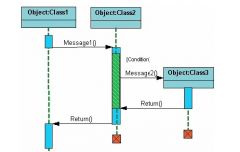
What is this diagram?
|
This is a sequence diagram
|
|
|
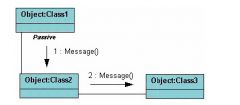
What kind of diagram is this?
|
A collaboration diagram.
|
|
|
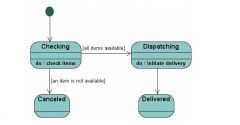
What kind of diagram is this and what does it show?
|
It is a state diagram that shows the different states of objects and how they collaborate.
|
|
|
|
What do objects look like in a collaboration diagram? In a state diagram?
|
In a collaboration diagram, objects are rectangles. In a state diagram they are rectangles with rounded corners.
|
|
|
|
How are collaboration and sequence diagrams the same? Different?
|
Collaboration diagrams are the same because they show the sequence of events. They are different because the focus is on object roles in a collaboration diagram.
|
|
|
|
What is the purpose of a Communication diagram? What was it in UML 1.x?
|
Communication diagrams have a free-form layout, so you can position objects to emphasize their relationships. Communication diagrams typically describe one instance, or a single path, of program execution. They were referred to as collaboration diagrams in UML 1.x.
|
|
|
|
What is the purpose of a statechart diagram?
|
They are important in modeling the behavior of an interface, class or collaboration, and emphasize the event-ordered behavior of an object. This is useful in modeling reactive systems.
|
|
|
|
Where have you seen statechart diagrams before?
|
They are used extensively in the Oracle SQL Reference.
|
|
|
|
What is a special kind of statechart diagram that shows the flow from activity to activity within the system.
|
An activity diagram.
|
|
|
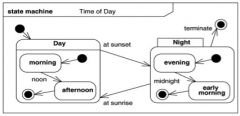
Where is the composite state in this diagram?
|
The Day is a composite state because it has a region.
|
|
|
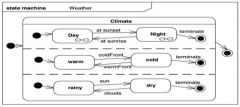
Where is the orthogonal state? What does orthogonal mean?
|
The climate is an orthogonal state. Orthogonal means that the regions are independent.
|
|
|
|
What do component diagrams address?
|
The static implementation view of system. Component diagram shows the organizations and dependencies among a set of components.
|
|
|
|
How are component diagrams similar to class diagrams?
|
They are related in that a component diagram typically maps to one or more classes, interfaces or collaborations.
|
|
|
|
What is a deployment diagram?
|
A deployment diagram shows the configuration of run-time processing nodes and the components that live on these nodes.
|
|
|
|
What are the five perspectives through which UML views a system?
|
Use Case View, Design View, Component View, Deployment View, and Process view;
|
|
|
|
How do the Use Case and Anslysis model view a system differently?
|
The use case is an external view of the system, an analysis is the internal view of a system.
|
|
|
|
How are the Use Case and Analysis models used differently?
|
The Use Case is used primarily as a contract between the customer and developers on what the system should and should not do. The Analysis Model is for developers to decide how it should be shaped.
|
|
|
|
How do the languages of the Use Case Model and the Analysis model differ?
|
The Use Case model uses the language of the customer. The Analysis Model uses the language of the developer.
|
|
|

What is this and how is it used?
|
It is a boundary Class. Used for modelng interactions between the actors and the system.
|
|
|

What is this?
|
A control class represents the coordination, computation, and sequencing activities within the system.
|
|
|
|
What is an Analysis Package?
|
It consists of classes, use case realizations and other analysis packages.
Based on functional requirements and problem domain (not non-functional and solution domain) |
|
|
|
Which Analysis Class does the user ideally deal with?
|
Only the boundary class.
|
|
|
|
What is the purpose of the control class?
|
These classes typically don't contain any business functionality. However, their main task is to transfer control to the appropriate business logic class, depending on a few inputs received from the boundary classes.
|
|

